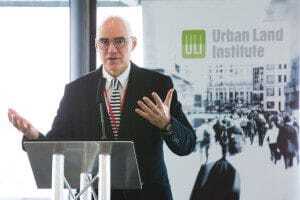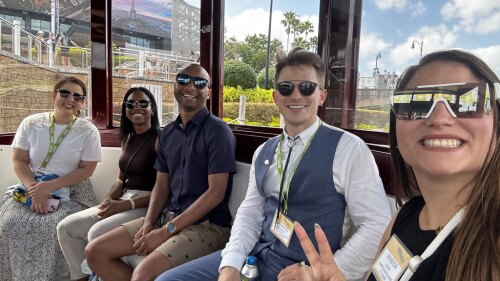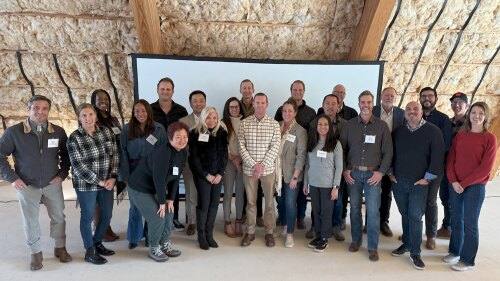Christopher Choa is the chair of the ULI UK Infrastructure Council and a vice president in AECOM’s London office, where he leads city-scale projects worldwide. In October, the council hosted a daylong conference at London City Hall on driverless cars and their implications for cities and real estate. The various sessions drew people from a range of stakeholders: manufacturers, government, academia, technology firms investing in driverless car research and development, developers, urban planners, and insurance professionals, as well as representatives from groups keen to bring the benefits of driverless cars to vulnerable populations—people who are sight-impaired or disabled, for example.
ULI Connect spoke with Choa about the highlights of the conference, as well as the tremendous opportunities driverless or automated vehicles can offer to cities, real estate, and residents.
What implications do driverless or automated vehicles have for cities?
The biggest promise is that there will be more space for people. Currently in Europe, up to 30 percent of urban land is devoted to roadways and parking. In the U.S., the number goes up to 50 percent. Potentially, 90 percent of that available road space could be turned over to development and public realm.
These areas are in prime, central-city locations. Parking infrastructure like garages and lots could be repurposed as commercial, mixed-use, or residential projects. Expressways and access ramps could become new brownfield developments. And there could be great improvements in open spaces because there will simply be more room for pedestrian- and cycling-oriented infrastructure—covered crosswalks, elimination of curbs, more bike stands, more landscape and playgrounds instead of car parking.
Autonomous vehicles will greatly reduce the number of cars overall—perhaps by a factor of ten. They also will reduce overall travel times for users, as sensors and software allow cars to merge and cross seamlessly, using up to eight times less travel area in the process.
There are major implications for emergency services: response times for fire and ambulance vehicles will be more rapid because they won’t be competing with as many cars on the road. Also, autonomous movement means freeing up capacity on tunnels, bridges, and other public infrastructure that is under stress. That means these major assets might not have to be expanded—or built in the first place.
Perhaps most importantly, though, are implications for public safety. Ninety-three percent of vehicular deaths are caused by human error, with 1.2 million vehicular deaths worldwide every year. The public health and safety benefits of driverless cars can’t be overstated. Insurance premiums will also go down, with liability shifted from the driver to the vehicle manufacturer.
What about private real estate development? What sort of market opportunities does the freeing up of all this land create for property owners and investors?
Obviously, the opportunities are huge, particularly around the question of housing. I can’t think of any successful city that isn’t facing enormous housing pressures. What city would say, “We don’t need land for housing, for young people who want to live and work in the heart of our area”?
There is strong potential for public/private partnerships as government-owned roadways are made available to new development. Data companies will need to commit to expensive upfront investments that make the driverless systems possible; perhaps they will be incentivized by development rights. We will need regulations to lock in long-term benefits for cities and the broader development community.
It seems we are actually talking about two distinct concepts: one, driverless cars or cars with some degree of automation, and two, the role shared vehicles play in a broader move toward a sharing economy.
This is true. We are increasingly living in an age of sharing. And to be clear, many of the benefits of automation and driverless vehicles are really attributable to the fact that they will mostly be shared resources.
Think about car-sharing services like Uber or ZipCar. People are moving away from personal ownership to shared access, not only for convenience, but also for economic and lifestyle reasons. I haven’t owned a vehicle since 2002, and my total expenses for vehicular movement have been slashed by a factor of ten. And that’s the real moral of the story: we increasingly value access and experience more than ownership of the commodity.
What do you believe are some of the myths related to autonomous vehicles?
One myth is that you can’t get a driverless car today. In fact, you can go to a number of dealers right now and ride away in a car that will not only have automatic cruise control, it will reliably detect cars around it, change lanes on its own, find a parking space, and park itself. A Tesla today is able to navigate relatively autonomously in a wide range of road and traffic conditions, and you can wireless-upgrade the operating system from time to time, just as you would on a smartphone.
The technology for full go-anywhere autonomy isn’t 100 percent yet. There will continue to be gradual increases in self-driving features, some of them impressive. However, the real issue is that full autonomy—which really means that you don’t need to be prepared to assume control of the vehicle—will only happen when there is widespread acceptance of driverless technology, and that will only happen after several evolutions in machine intelligence. These advances are progressing rapidly, but still have a way to go.
Another myth is that autonomous vehicles will be marketed primarily to individual owners. That’s not likely. It’s really big fleet operators—think of Uber, ZipCar—that will make the driverless access available. It’s a data-driven technology—think more Google and less Ford. And the access model will also tend to follow how we pay for information now—on a pay-as-you-go basis.
Does all this mean that we won’t really be seeing driverless cars in our cities anytime soon?
Actually, quite a few cities are already trialing driverless cars right now. It’s unlikely that an entire geographical region would become driverless soon, but it is relatively easy for pockets within cities to reserve themselves exclusively for driverless vehicles: only cars with validated autonomous capabilities would be able to enter, similar to the way congestion-charging zones work now. These areas will be more attractive and safer for a wide variety of reasons, and will in turn motivate other areas to do the same.
In terms of climate change adaptation and mitigation, what role do driverless vehicles play in reducing emissions or helping cities adapt to new climate realities?
In terms of mitigation, the biggest impact comes by dramatically reducing our global fuel requirements, which come out to about 700 million gallons [2.6 billion liters] per year. Drastically reduce the number of cars on the road—because mobility will become a shared asset—and you also drastically reduce the amount of energy consumption, and ultimately our related greenhouse gas emissions.
Freeing up land in cities that was once devoted to roads and parking means governments, planners, and developers can also be more flexible in how they can adapt to sea-level rise, flooding, rising temperatures, and other realities of climate change.
What were you hoping to achieve by hosting a conference on driverless cars, and do you feel the event was a success?
There was a huge amount of interest, and it wasn’t the usual players who showed up. We had people from a much broader sector than real estate and planning. Advocates from the disabled community, for example, are really interested in seeing where this technology goes and how it can help them have mobility that they have never had before.
Read a recap of the ULI UK’s Driverless Cars and the City conference.





